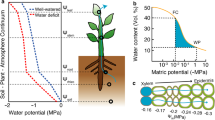Abstract
Day/night changes in turgor pressure (P) and titratable acidity content were investigated in the (Crassulacean-acid-metabolism (CAM) plant Kalanchoe daigremontiana. Measurements of P were made on individual mesophyll cells of intact attached leaves using the pressure-probe technique. Under conditions of high relative humidity, when transpiration rates were minimal, changes in P correlated well with changes in the level of titratable acidity. During the standard 12 h light/12 h dark cycle, maximum turgor pressure (0.15 MPa) occurred at the end of the dark period when the level of titratable acidity was highest (about 300 μeq H+·g-1 fresh weight). A close relationship between P and titratable acidity was also seen in leaves exposed to perturbations of the standard light/dark cycle. (The dark period was either prolonged, or else only CO2-free air was supplied in this period). In plants deprived of irrigation for five weeks, diurnal changes in titratable acidity of the leaves were reduced (ΔH=160 μeq H+·g-1 fresh weight) and P increased from essentially zero at the end of the light period to 0.02 MPa at the end of the dark period. Following more severe water stress (experiments were made on leaves which had been detached for five weeks), P was zero throughout day and night, yet small diurnal changes in titratable acidity were still measured. These findings are discussed in relation to a hypothesis by Lüttge et al. 1975 (Plant Physiol. 56,613-616) for the role of P in the regulation of acidification/de-acidification cycles of plants exhibiting CAM.
Similar content being viewed by others
Abbreviations
- CAM:
-
crassulacean acid metabolism
- FW:
-
fresh weight
- P :
-
turgor pressure
References
Coster, H.G.L., Zimmermann, U. (1976) Transduction of turgor pressure by cell membrane compression. Z. Naturforsch. 31c, 461–463
Gutknecht, J. (1968) Salt transport in Valonia: Inhibition of potassium uptake by small hydrostatic pressures. Science 160, 68–70
Gutknecht, J., Hastings, D.F., Bisson, M.A. (1978) Ion transport and turgor pressure regulation in giant algal cells. In: Membrane transport in biology, vol. III, pp. 125–174, Giebisch, G., Tosteson, D.C., Ussing, H.H., eds. Springer, New York
Hüsken, D., Steudle, E., Zimmermann, U. (1978) Pressure probe technique for measuring water relations of cells in higher plants. Plant Physiol. 61, 158–163
Kluge, M., Ting, I.P. (1978) Crassulacean acid metabolism: Analysis of an ecological adaptation. Springer, Berlin Heidelberg New York
Lüttge, U. (1986) Nocturnal water storage in plants having Crassulacean acid metabolism. Planta 168, 287–289
Lüttge, U., Ball, E., Tromballa, H.W. (1975a) K+ independence of osmoregulated oscillations of malate2- levels in the cells of CAM-leaves. Biochem. Physiol. Pflanz. 167, 267–283
Lüttge, U., Kluge, M., Ball, E. (1975b) Effects of osmotic gradients on vacuolar malic acid storage. A basic principle in oscillatory behaviour of Crassulacean acid metabolism. Plant Physiol. 56, 613–616
Lüttge, U., Nobel, P.S. (1984) Day-night variations in malate concentration, osmotic pressure, and hydrostatic pressure in Cereus validus. Plant Physiol. 75, 804–807
Richardson, I.W., Licko, V., Bartoli, E. (1973) The nature of passive flows through tightly folded membranes. The influence of microstructure. J. Membr. Biol. 11, 293–308
Ruess, B.R., Eller, B.M. (1985) The correlation between crassulacean acid metabolism and water uptake in Senecio medleywoodii. Planta 166, 57–66
Rygol, J., Büchner, K.-H., Winter K., Zimmermann, U. (1986) Day/night variations in turgor pressure in individual cells of Mesembryanthemum crystallinum L. Oecologia 69, 171–175
Rygol, J., Lüttge, U. (1983) Water-relation parameters of giant and normal cells of Capsicum annuum pericarp. Plant Cell Environ. 6, 545–553
Smith, J.A.C., Lüttge, U. (1985) Day-night changes in leaf water relations associated with the rhythm of crassulacean acid metabolism in Kalanchoe daigremontiana. Planta 163, 272–282
Steudle, E., Smith, J.A.C., Lüttge, U. (1980) Water-relations parameters of individual mesophyll cells of the crassulacean acid metabolism plant Kalanchoe daigremontiana. Plant Physiol. 66, 1155–1163
Steudle, E., Zimmermann, U., Zillikens, J. (1982) Effect of cell turgor on hydraulic conductivity and elastic modulus of Elodea leaf cells. Planta 154, 371–380
Winter, K. (1985) Crassulacean acid metabolism. In: Photosynthetic mechanisms and the environment, pp. 329–387, Barber, J., Baker, N.R., eds. Elsevier, Amsterdam
Winter, K. (1987) Gradient in the degree of Crassulacean acid metabolism within leaves of Kalanchoe daigremontiana. Planta, in press
Winter, K., Edwards, G.E., Holtum, J.A.M. (1981) Nocturnal accumulation of malic acid occurs in mesophyll tissue without proton transport to epidermal tissue in the inducible Crassulacean acid metabolism plant Mesembryanthemum crystallinum. Plant Physiol. 68, 355–357
Winter, K., Schröppel-Meier, G., Caldwell, M.M. (1986) Respiratory CO2 as carbon source for nocturnal acid synthesis at high temperatures in three species exhibiting Crassulacean acid metabolism. Plant Physiol. 81, 390–394
Zimmermann, U. (1978) Physics of turgor-and osmoregulation. Annu. Rev. Plant. Physiol. 29, 121–148
Zimmermann, U., Raede, H., Steudle, E. (1969) Kontinuierliche Druckmessungen in Pflanzenzellen. Naturwissenschaften 56, 643
Zimmermann, U., Steudle, E. (1974) The pressure dependence of the hydraulic conductivity, the cell membrane resistance and the membrane potential during turgor pressure regulation in Valonia utricularis. J. Membr. Biol. 16, 331–352
Zimmermann, U., Steudle, E. (1978a) Hydraulic conductivity and volumetric elastic modulus in giant algal cells: Pressure-and volume-dependence. In: Membrane transport in plants, pp. 64–71, Zimmermann, U., Dainty, J., eds. Springer, Berlin Heidelberg New York
Zimmermann, U., Steudle, E. (1978b) Physical aspects of water relations of plant cells. Adv. Bot. Res. 6, 45–117
Zimmermann, U., Steudle, E. (1980) Fundamental water relations parameters. In: Plant membrane transport: Current conceptual issues, pp. 113–127, Spanswick, R.M., Lucas, W.J., Dainty, J., eds. Elsevier/North Holland, Amsterdam
Author information
Authors and Affiliations
Rights and permissions
About this article
Cite this article
Rygol, J., Winter, K. & Zimmermann, U. The relationship between turgor pressure and titratable acidity in mesophyll cells of intact leaves of a Crassulacean-acid-metabolism plant, Kalanchoe daigremontiana Hamet et Perr. Planta 172, 487–493 (1987). https://doi.org/10.1007/BF00393864
Received:
Accepted:
Issue Date:
DOI: https://doi.org/10.1007/BF00393864




